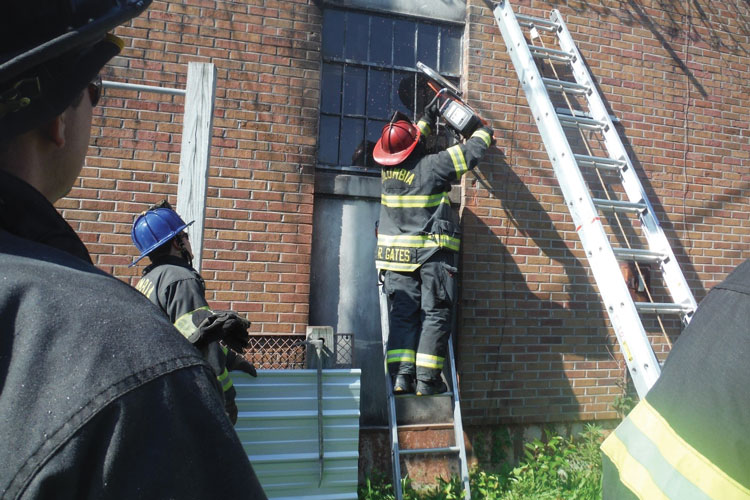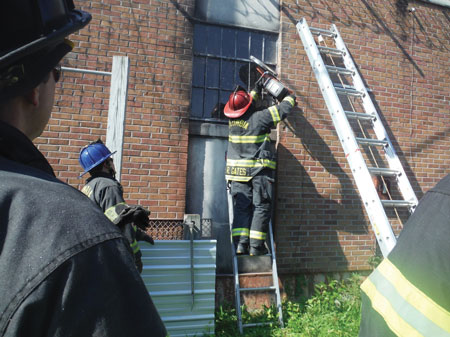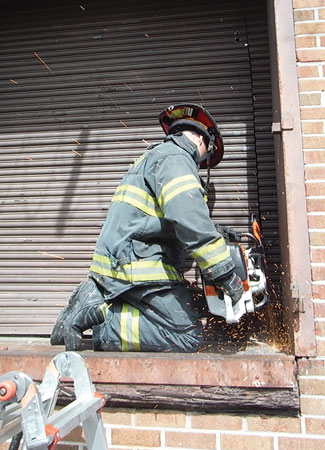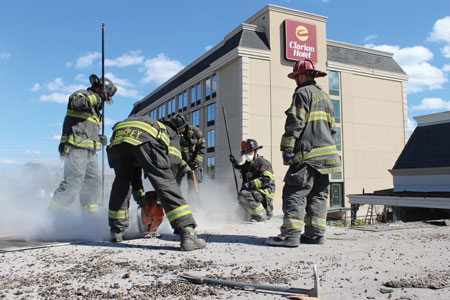
By Jason Joannides
Years ago, one of the first traits I was taught as a young probationary firefighter was to adapt and overcome every situation, no matter what. Today, the fire department budget is scrutinized and reduced more than ever in many fire departments across the country. A few years ago, I was able to adapt and build the Columbia (SC) Fire Department (CFD) Acquired Building Program. We can only learn and train so much on our training academy burn buildings until personnel realize that the fire is always in one of two locations and that it is 30 feet from the front door to the fire location. Acquired buildings have enabled our fire department to take training to an entirely new level – and at no cost to the department. These acquired structures were used exclusively for forcible entry and ventilation exercises, not for live burn purposes.
 |
| (1) Here are some of the construction surprises you will find on residential acquired structures. (Photos by author.) |
The main concept of the CFD Acquired Building Program involves building relationships by talking to the community, business leaders, and developers. I emphasize “talking,” not e-mailing. It is important to get out of the office or firehouse and go meet and greet. Explain to the average community developers what this training could do for “their fire department” and what an impact it could make for years to come. They may give you a small single-family dwelling about to be demolished or an entire apartment complex, but either way it’s a start. Build on it, and don’t be afraid to get out of your comfort zone.
Over three years, I’ve had the opportunity to run drills in more than 100 acquired buildings ranging from single-family dwellings to multifamily apartment complexes, commercial occupancies, and an eight-story mid-rise. Each building had a main training objective as well as a secondary objective: build the companies’ skill level and training one step higher than the last time. The acquired building’s construction and configuration then played into where I would focus my skill set: forcible entry, egress, roof operations, and rapid intervention team (RIT) operations. Many buildings allowed us to focus on multiple skill sets as well as run full-scale scenarios to incorporate real-life timing and coordination with other companies.
The Training and the Lessons
Here are just some of the skill sets we have trained on in these acquired buildings and the lessons we learned.
Forcible entry. Whether on wood frame, lightweight metal, or steel doors, one tactic we confirmed was that “Shock, Gap, Set, Force” does work! More than 90 percent of the time (on wood or lightweight metal), shocking the door with a halligan and starting high, low, and then middle worked to ensure the door opened or cracked open enough that we could place the adz in the frame and force down. It sounds simple, but it continuously worked. Even on the wood doors that had wood drop-bars attached, a simple “Gap, Set, Force” opened them quickly.
Roll-up doors. Like many construction features in our business, there are many styles of roll-up doors. We’ve had the opportunity to cut slatted metal roll-up doors and slatted metal doors that were welded at the seams for added protection. All the doors we have cut had an interior manual chain to open the doors, which, if conditions exist, would be the “go-to” option. We practiced forcing the door next to the roll-up door, forcing the lock off the chain using hand tools, and manually rolling them up and locking them. In a worst-case scenario, you may be unable to access the interior and have to cut the roll-up doors quickly for access.
 |
| (2) Companies use a rotary saw with a multipurpose blade on window bars that are recessed into concrete. |
We focused our efforts on the three basic cuts: the “A” or “teepee” cut, the box cut, and the slat cut. The A cut worked very well and quickly on the lighter-gauge metal garage doors; however, the main issue, as many of you are aware, is the member becomes tired as he “pulls” the cut inward, resulting in a small cut. The box cut worked very well on all styles of doors. It took, on average, one to one-and-a-half minutes longer because of having to make the third and possibly fourth cuts (foothold on the bottom slat). The slat cut worked great on regular “slat” garage doors. It didn’t fare so well on the metal slatted roll-up door that was welded.
The results were as follows: On 32 roll-up doors, the box cut provided the maximum amount of opening in the fastest time with one firefighter. However, if you need initial knockdown of the fire to make entry, start with the A cut and finish it off with a modified box cut. This enables you to get water on the fire faster while maximizing your opening.
A note on egress: Window bars, casement-style windows, and other manufactured devices (professional or homemade) on windows and doors should be an important size-up radio transmission. It’s disturbing to hear firefighters and officers say, “If the situation went bad, those windows bars wouldn’t have been an issue.” You’re exactly right, because you have plenty of time when the room is about to flash, you need to call a Mayday, and you’re using your one good hand to break the window AND remove the bars. The point is, anything that prevents you from entering will prevent you from exiting!
Window bars. Amazingly, almost all the single-family buildings we’ve acquired had window bars on them. Almost half of them were probably installed by the homeowner with cheap two- to three-inch wood screws. Many firefighters look at these devices and immediately think “rotary saw.” That means you run back to the rig; start the saw; and usually cut the bars in an awkward position and over your head, which is not efficient. Hand tools have defeated these bars easily and with less effort than our rotary saws.
 |
| (3) Using a rotary saw, this officer is making a box cut on a fortified steel roll-up door. |
I suggest using a 54-inch halligan bar. It provides tremendous leverage that completely shears the screws and lag bolts off. Work the top and bottom of one side and swing the window bars in the opposite direction with your arms; they’ll pop right off. Remember, some window bars are reinforced or set into concrete or mortar. These bars will require some sort of saw. If your apparatus has portable “e-hydraulics,” using the spreaders on these bars can also be very effective and efficient.
Casement windows. Casement windows usually hinge inward or outward from one or both sides of the windows. These windows can be made of vinyl or metal/light-gauge steel. Steel casement windows are extremely dangerous and have been known to trap firefighters in rapid fire conditions. Although they sometimes look like normal windows, up close you can see the hinges on either side of the windows. We found steel casement windows on a normal two-story apartment complex slated for demolition. Casement windows are very tiring and difficult to force or remove from the inside, and you must communicate their presence to outside crews! It can be very tough to force casement windows using hand tools, but it can be done. A more effective method of removal is the rotary saw or a portable “e-hydraulic” cutter. Below are other tools and tactics for removing casement windows.
- Hand tools. Using a halligan or an eight-pound flathead ax, remove the window glass and force one or both hinged openings. Then “attack” the top joint of the center bar. Continue to remove the section of metal slash until the opening is clear.
- Rotary saw. Using a hand tool, remove a few panes of glass on the sides of the hinged window. Using a “multipurpose” blade, cut the top section of the casement window. Using a hand tool, preferably a roof hook, pull down the “cut” section of the casement window. Now you have full access to the window, with the lower section of the window hanging down. Take the time to cut and remove the lower sections of the casement window and pull them completely off the building. This tactic added about 20 seconds to the scenario.
- E-hydraulic cutters. Although not all apparatus have battery-operated cutters, this was the most efficient tool to use on casement windows. Take the top panes of glass out with a hand tool and cut the metal slashes out of the windows, starting at the top and working to the bottom cuts. On single- and double-hinged casement windows, this tactic took less than 40 seconds.
Wood roofs. When dealing with older acquired buildings, it is common to encounter six to 10 layers of shingles on top of wood slats or plywood sheathing. Thus, it is highly recommended that you run your chain saw without a depth gauge or guard. This piece of equipment will hamper your efforts in providing a quick, efficient, and adequate ventilation hole in these types of structures.
 |
| (4) On lightweight concrete flat roofs, the rotary saw with a carbide-tip blade was more effective than other blades. |
When working with a chain saw, I recommend using the “Roll three, Cut three” technique: Sink the saw blade and essentially roll three rafters and cut downward or “dice” three times. Then you’ll finish the bottom cut and begin to open up and punch through the attic space. This method has been proven time and time again on multiple layers of conventional construction as well as lightweight construction wood roofs, with an average time of 1:52 for an approximate six by six hole.
Lightweight concrete roofs. These roofs, commonly found in our response area, can be cumbersome – with an average of four to more than nine inches of material. Multiple acquired buildings had this roof type. We found that a carbide-tipped rotary saw blade (18 teeth for a 14-inch blade) was the best and most effective option on this roofing style. When we started cutting on a large hotel structure, we narrowed our time to cut a three- by nine-foot hole from more than 12 minutes to just around six minutes. We also found that adding two additional personnel to the roof (a total of four) lowered the time to 41/2 minutes. A member using one rotary saw while other members perforated the saw lines with a halligan or an eight-pound ax drastically increased the efficiently of opening up a lightweight concrete roof.
 |
| (5) A firefighter uses a rotary saw to cut the top portion of a steel casement window. Rotary saws are more effective than hand tools on casement windows. |
RIT operations. RIT scenarios are easy to train on in acquired buildings. One of the main objectives I focused on was the window-to-door conversion for removal of a down firefighter or larger victim. When companies found an unresponsive firefighter, they communicated the information as the RIT began a window-to-door conversion on the acquired building. We have performed more than 160 conversions on wood-frame, stucco, and brick structures: Results showed that using hand tools to open the wall to the floor board for removal beat power tools 154 times. That’s a 96.5-percent chance that your hand tool will beat a power tool. During these experiments, we tested the theory with two, three, and four personnel on multiple windows on each structure. During this research, the only variables were the personnel and the structures. We have found the most effective method was the following:
- Remove the window/glass.
- Using the back of an eight-pound ax, start just below the window, and begin striking the structure with your tool.
- Each person strikes the structure only eight times and passes the tool to the next member.
- As the exterior fastening begins to fall, an extra member, if available, removes the debris from under the window. Doing this now will speed up the removal process.
- As you begin to open up the structure, one member pulls the debris using a roof hook.
- Once at the floor level, continue to strike the exterior material inward to finish the conversion.
- Immediately remove the down firefighter or victim.
In our experiments, we have averaged a time from start to finish of 3:18. Some companies made a conversion as quickly as 2:15 and as slow as 8:03. The average power tool time was 4:45 from start to finish.
 |
| (6) A portable “e-hydraulic” cutter was the most effective and efficient tool to remove steel casement windows on these acquired apartment buildings. |
There were some additional disadvantages to using power tools. The tools would bind up in the materials (especially wood-frame residential materials). During the cutting of the brick structures, heavy dust from the mortar hampered some companies, forcing them to stop and go on air using their self-contained breathing apparatus. As additional acquired structures become available, we will continue to look at perfecting the window-to-door conversion as well as other RIT skills, including performing belowgrade rescues with limited staffing.
As you continue to set the training course for your department, try to use acquired structures in your training. Start with your current operations and skill sets and challenge yourself and your department by asking, “Is what we are doing best practice for the citizens and us?” There are some things that shouldn’t change; however, I challenge myself to ensure we’ve exhausted the options first before I “settle” for how we do business.
JASON JOANNIDES is a 15-year veteran of the fire service and a captain in the Columbia (SC) Fire Department Training Bureau. He manages the acquired structure program, truck company, and support schools. He was previously assigned to Ladder 7 in the North Columbia area. Joannides is also the vice president of SAFE Firefighter LLC and the Palmetto F.O.O.L.S.
Jason Joannides will present “Proven Truck Tactics That Might Surprise You” at FDIC International in Indianapolis on Monday, April 24, 2017, 8:00 a.m.-12:00 p.m.
ACQUIRING STRUCTURES FOR TRAINING
Maximizing Training Evolutions in an Acquired Structure
Necessary, Dangerous, or Both: Live Fire Training in Acquired Structures
Fire Engineering Archives

